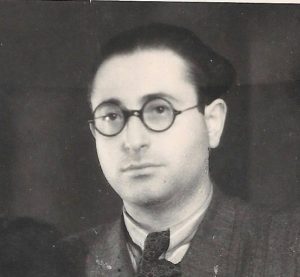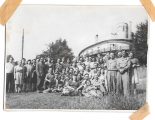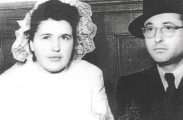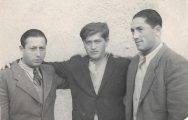- Local Survivor registry
- MORRIS BORENSTEIN
- Local Survivor registry
- MORRIS BORENSTEIN
Survivor Profile

MORRIS
BORENSTEIN
(1915-2004)
PRE-WAR NAME:
MOSHE AARON BORENSTEIN
MOSHE AARON BORENSTEIN
PLACE OF BIRTH:
LODZ, POLAND
LODZ, POLAND
DATE OF BIRTH:
AUGUST 15, 1915
AUGUST 15, 1915
LOCATION(s) BEFORE THE WAR:
LODZ, POLAND
LODZ, POLAND
LOCATION(s) DURING THE WAR:
LODZ GHETTO; AUSCHWITZ, FIVE CONCENTRATION CAMPS; DEATH MARCH
LODZ GHETTO; AUSCHWITZ, FIVE CONCENTRATION CAMPS; DEATH MARCH
STATUS:
SURVIVOR
SURVIVOR
RELATED PERSON(S):
MALA (MALAKA) EISENBERG BORENSTEIN - Spouse (Deceased),
SUSAN BORENSTEIN HIRSCH - Daughter,
ELLEN BORENSTEIN CAMHI - Daughter,
CHAIM BORENSTEIN - Son,
ANDREW HIRSCH - Son-in-law
-
BRIEF BIOGRAPHY BY NANCY GORRELL
Morris (Moshe) Borenstein was born August 15, 1915 in Lodz, Poland. He was 24 years old when Hitler formed the Lodz ghetto after the invasion of September 1939. Morris experienced the entire war from the Lodz ghetto, to Auschwitz and a death march. According to his daughters, Susan and Ellen in their interview, he was in at least five camps, although they do not know the exact names. Morris never talked about his childhood in Lodz or his concentration camp experiences with his family.
Morris came from a religious family. His father was a bookkeeper. Morris had a brother, Milton and a sister, Devorah, who survived the war. His parents stressed religion. They went to synagogue in Lodz. In the end, his daughters recall their father going to shul and studying torah. His death wish was to be buried in Israel. He passed in 2004 and is buried on Mount of Olives.
As far as his war experiences are concerned, he never gave details, but he did reveal that people were starving and dying in the Lodz ghetto. His daughters surmise in their interview that their father had to be in Auschwitz a short time because he went there as well as five other camps. He had numbers on his arm and told them about a time in Auschwitz. He said he went on one line and his parents went on another, and he was with his younger brother. His parents didn’t survive. He told them little about liberation, but they know their parents met in the American zone in Germany at a Displaced Persons Camp, most likely Feldafing in 1946. Both he and Mala Borenstein, his future wife, recuperated in a hospital for almost two years before they got married. They came to the United States in June of 1949, when Mala was pregnant with Ellen (Esther), their first child.
Morris and his wife were sponsored by Mala’s wealthy cousin, Yakov Eisenberg, who owned a leather goods factory in New York City. Morris got a job in another factory making leather goods and pocketbooks (not Eisenberg’s factory). His daughter, Susan describes him as “a laborer who worked around the clock. He even worked Sundays.” Outside the house he was well-liked by the people in the shul, but “absent with his family.”
Susan and Ellen recall that he liked fixing things—especially electronics, and that is how he liked to spend his time. In 1972 after 24 years of marriage, Morris and Mala separated. Years later, Morris remarried. He enjoyed the grandchildren, but when his second wife died, “he could no longer handle the stress.” According to Susan, “He was not a happy person.” Still, he lived to be 89 years old. “He was a fighter.”
Editor’s Note:
Refer to Historical Notes below for the Lodz Ghetto
-
SURVIVOR INTERVIEW:
MORRIS BORENSTEIN INTERVIEW WITH SUSAN HIRSCH, DAUGHTER
AND ELLEN CAMHI, DAUGHTER
Date: August 4, 2017
Location: Hirsch residence
Interviewer: Nancy Gorrell
Q: Describe your father’s family background.
My father’s father was a bookkeeper and very religious. He had seven siblings plus himself. He had a brother and sister who survived, Milton and Devorah. Morris was the youngest of the siblings. They came from Lodz, a big industrial city southwest of Warsaw. They were very poor. My father never talked about Lodz. He never talked about his childhood. My father liked to fix things electronically, and that’s what he did.
Q: What kind of education did he experience?
His parents stressed religion. Religion was an important part of their lives. They went to the synagogue. At the end, my father studied torah, and his death wish was to be buried in Israel. He’s buried on Mount of Olives today.
Q: Did he talk about what happened when the war broke out?
He never talked about it; we knew very little.Q: What did he tell you about the ghetto experience?
He never gave details except that he was starving and people died. He had to be there for a short period of time because he went to five different camps; that he told me.Q: What do you know about his Auschwitz experience?
He went on one line and his parents went on another, and he was with his younger brother. His parents didn’t survived. He definitely had numbers on his arm.Q: What about his liberation and his post-war experience?
Both my parents met in a hospital in the American zone in Germany while recuperating. They were there for a long time, a year or two. At least until 1947; they got married there. It was the Displaced Persons Camp, Feldafing. My mother had tuberculosis and typhoid.Q: When did your parents emigrate from the DP camp to the United States?
They came in 1949, June I think. My mother was six months pregnant with my sister, Ellen, who was born September 28, 1949. A wealthy cousin, Yakov Eisenberg, who owned Desco Shoes, sponsored us to come.Q: What did your father do when he arrived?
My father got a job in a factory. They rented a room in Ida and Joseph’s Toph’s house in East New York. They stayed in a rented room there around two years. He worked in a factory making pocketbooks for several years and then moved to Dumont Street. The Eisenbergs did give us jobs one summer when we were teenagers.Q: What was it like for you growing up with survivor parents?
My father was an absentee father. He was a laborer who worked around the clock. He even worked Sundays. He had a sense of humor, but not with his family, more with other people. He was very well-liked by the people in the shul, but absent with his family. At home, he was not a happy person.Q: What were his later years like?
My parents got divorced after 24 years of marriage. They got divorced after I got married. They separated around 1972. When my father passed away, they all thought of him as a happy guy—a nicer older man, but he was a difficult father. My father remarried quite a few years later. He lost the ability to love. He was depressed, and he couldn’t handle stress in his later years. His coping skills were gone. He saved a lot of money in his position. But he was damaged from the war. We understand him now. He was happy to see the grandchildren. My mother never remarried because she never trusted anyone. When my father’s 2nd wife died, he went into depression. He lived a long time, until he was 89. He was a fighter.Editor’s Note:
Susan Hirsch relates the following Story About My Deceased Father to conclude the Interview.
Dad died in 2004 in June. After he died, my mother died three years later. My sister would visit my mom’s grave in Staten Island. There, she saw a rabbi that looked just like my father. At least a year later, I was visiting the cemetery and saw the rabbi that looked like my father. I took a picture of him. After that, my brother’s friend’s sister died and my brother went to the cemetery to visit this girl, and when he turns around, he sees our mother’s gravesite, and then my brother sees the rabbi that looks just like my Dad. We gave the rabbi our phone number. And then we never saw him again. All three of us saw the rabbi that looked like my father. How can you explain that?
-
HISTORICAL NOTES:
THE LODZ GHETTO
The Łódź Ghetto (German: Ghetto Litzmannstadt) was a World War II ghetto established by the Nazi German authorities for Polish Jews and Roma following the 1939 invasion of Poland. It was the second-largest ghetto in all of German-occupied Europe after the Warsaw Ghetto. Situated in the city of Łódź, and originally intended as a preliminary step upon a more extensive plan of creating the Judenfrei province of Warthegau, the ghetto was transformed into a major industrial centre, manufacturing much needed war supplies for Nazi Germany and especially for the German Army. The number of people incarcerated in it was augmented further by the Jews deported from the Reich territories. Because of its remarkable productivity, the ghetto managed to survive until August 1944. In the first two years, it absorbed almost 20,000 Jews from liquidated ghettos in nearby Polish towns and villages, as well as 20,000 more from the rest of German-occupied Europe. After the wave of deportations to Chełmno death camp beginning in early 1942, and in spite of a stark reversal of fortune, the Germans persisted in eradicating the ghetto: they transported the remaining population to Auschwitz and Chełmno extermination camps, where most were murdered upon arrival. It was the last ghetto in occupied Poland to be liquidated. A total of 204,000 Jews passed through it; but only 877 remained hidden when the Soviets arrived. About 10,000 Jewish residents of Łódź, who used to live there before the invasion of Poland, survived the Holocaust elsewhere.
-
Sources and Credits:
Credits: SSBJCC Interview August 4, 2017 with Susan Hirsch, daughter and Ellen Camhi, daughter; Digital and historic family photographs donated by Susan Hirsch; Biography by Nancy Gorrell






